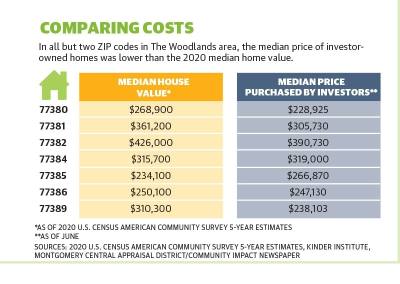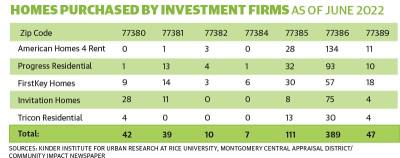In The Woodlands area, while outside investment firms are not typically buying homes within the township’s borders, clusters of these purchases have occurred in newer developments along the Grand Parkway, Rayford Road, and other parts of south Montgomery and north Harris counties.
The Houston Association of Realtors reported June 15 that year-over-year rentals increased 24.8% from May 2021 to May 2022. While rising mortgages and low inventory are contributing to the trend, experts said potential homebuyers are also facing competition from real estate investment firms, or institutional buyers, buying properties to sell or lease.
“These are not mom and pop buyers,” said Nadia Evangelou, the director of forecasting at the National Association of Realtors. “They look to buy properties and communities on a large scale and make profit from them.”
Texas leads the nation in institutional buying with 28% of single-family homes purchased by firms in 2021—more than double the national average of 13%, according to data from the NAR. The state also saw the second-largest percent increase in properties bought by institutional buyers from 2020-21, climbing 4.6 percentage points.
The NAR reported institutional buyers purchased 29% of single-family properties purchased in Montgomery County and 38% of single-family properties purchased in Harris County in 2021.
Property data from the Montgomery Central Appraisal District shows 1,251 homes in Montgomery County and 645 homes in seven ZIP codes in The Woodlands area are owned by five institutional buyers and their subsidiaries as of June 2022: American Homes 4 Rent, Progress Residential, FirstKey Homes, Invitation Homes and Tricon Residential.
Haley Garcia, broker associate with Garcia Real Estate Group in The Woodlands, said a concentration of interest in areas near the Grand Parkway is related to growth in that corridor.“East of [I-]45, those areas are booming and very desirable, and I think it’s because the [Grand Parkway] has made everything so much more easily accessible, ... so they’re not on a lone island,” Garcia said.
However, homes within The Woodlands Township are somewhat protected from this trend because of the higher prices, area real estate experts said. Beth Ferester, a Realtor with Corcoran Ferester Realty in The Woodlands, said she has seen the firm’s presence grow in the region.
“I have been shocked that there are so many investors in this inflated market,” Ferester said. “They must know something about people wanting to just lease instead of purchase in the future.”
Rise in communities for rent
Evangelou said the trend for investment firms to buy properties causes first-time, low-income buyers to face steeper competition for home purchases as firms tend to target the same properties they would buy, are willing to pay cash and can offer services the average homebuyer cannot. Firms that have bought properties have also been investing into developing entire build-to-rent communities.
David Howard, executive director of the National Rental Home Council, a nonprofit that represents the single-family rental home industry, said 3% of NRHC companies were building homes for rent two years ago, compared to 26% in 2022.
Saher Said, a Realtor with Compass Real Estate who is based in The Woodlands, said one example of a local community built strictly for leasing properties is Amber Pines at Foster’s Ridge, a neighborhood of about 100 houses north of FM 1488.
Another build-to-rent community is Centro Modern, east of I-45 in Shenandoah. It was originally planned as single-family homes to purchase but has been managed by Bridge Tower as a build-to-rent community since 2021, District Property Manager Matlyn Smith said. The development is starting with 80 units in two floor plans including options with two or three stories, leases with terms of 12-24 months and monthly rent of $2,500-$2,800.
Smith said rental properties are a good fit for many people moving to the Greater Houston area, and the property managers at Centro Modern work with the local homeowners association to ensure it maintains similar standards.
“I think it’s partially a new concept; it gives people an option when they’re not ready to buy and want the flexibility of a lease,” Smith said.
An April study conducted by researchers at the University of California at Berkeley found American Homes 4 Rent and Canada-based Tricon Residential have invested millions of dollars as of the fourth quarter of 2021 in developing U.S. homes for rent. American Homes 4 Rent owns 336 homes in Montgomery County in its own name and through limited liability corporations listed on the U.S. Securities and Exchange Commission filings, HCAD data shows, while Tricon Residential owns 231 Montgomery County properties.
Evangelou said large millennial and minority renter populations and still-affordable housing contributed to the metro area’s status as a target for investors.
“To put it simply, Texas fits all the desired criteria,” she said.
Low supply, high prices
Institutional buying trends emerged as the housing industry is facing record lows in inventory. In May, the HAR reported the Houston-area market had 1.6 months of supply—the highest mark since October 2021 yet below the six-month mark the NAR considers a “balanced” market. HAR Chair Jennifer Wauhob said in a June 15 news release that conditions “appeared to be calming.
”Institutional buyers tend to target lower price points, according to Said.
In The Woodlands area, the ZIP codes with the largest number of institutional investor-owned homes are 77385 and 77386, which are also the ZIP codes with the lowest median home prices as of the U.S. Census Bureau 2020 American Community Survey five-year estimates at $234,100 and $250,100, respectively.
However, some rentals do occur in The Woodlands ZIP codes, such as 77381, where there are 39 homes owned by five of the largest investors in the area as of June.
“When it comes to The Woodlands, it will be the front sections that are more investment/lease properties,” Said said. “Those are usually properties that are priced below the average price point in the area. This would be parts of Grogan’s Mill and Panther Creek but then also part of the back by May Valley and Creekside Park.”
NAR data also found institutional buyers offered about the same price as other buyers but were willing to pay cash or offer other services that other buyers did not, such as home appraisals and inspections.
However, Said noted those cash offers did carry some disadvantages.
“These offers are usually strong and in cash but bring some issues for the sellers during the transaction as they carry hefty repair requests,” he said. Cash offers also affect first-time buyers and make a challenging market even more difficult to get into, according to Said.
“This pushes the first-time buyers from our area outside in order to get their first home,” he said.
Despite the challenges of getting into the market, Montgomery County is increasingly drawing buyers of all kinds as part of a larger trend away from metropolitan centers, Ferester said.
“I do believe since COVID[-19] people are moving further away from cities,” Ferester said.
Long-term impacts
Said said it is likely leases will continue to grow in popularity as a result of high interest rates as well as factors such as limited availability at apartment complexes. Although the median household income in The Woodlands was $126,087 as of the 2020 ACS five-year estimates—twice the statewide median of $63,826—leasing remains popular because the population includes many nonpermanent residents, he said.
“The rental market in The Woodlands houses a lot of expats, ... and most have a budget given by the company for their rental while in the area,” Said said.
Although institutional purchases dropped among national market shares from 2015-20 from 15.4% to 11.8%, they rose to 13.1% in 2021 during the real estate surge following the onset of the coronavirus pandemic, according to NAR data.
Wauhob said in a June 14 interview the HAR is beginning to upscale its effort to track institutional buying and build-to-rent options. She said the organization is looking at home ownership levels and home values, especially as increased prices affect appraisals and property taxes.
Charlie Kriegel, the owner of property advisers WinHill Advisors-Kirby in Houston, said national trends could see at least 40% of single-family homes under $400,000 owned by firms in the next three to five years, which would change the homebuying dynamic. “There’s no negotiating with an institutional buyer,” Kriegel said. “Anyone who’s buying for under $400,000 will need to understand that.”









